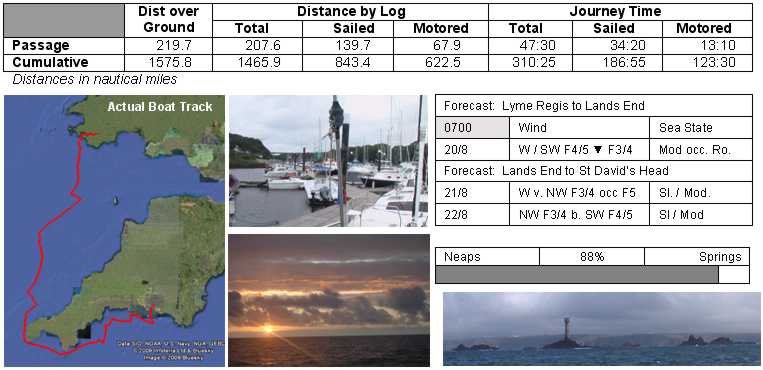

|
It was the 20th and we'd only managed five days sailing in August so if we were to make our target return date of 1st September we had to take advantage of the decent weather and abandon the hopes that we had of exploring Cornwall. We decided that we would keep going for as long as morale held up hoping for Holyhead or Milford Haven at least.
Lands End was the focus of our planning and again found Reeds far more useful than the Shell Channel Pilot (the detailed tidal chartlets in Reeds were particularly helpful). If the conditions were poor we would wait for a favourable tide and pass well offshore in the Inshore Traffic Zone. If conditions were more favourable we would cut the corner and endeavour to take full advantage of the potential 9½ hours of fair tide described in Reeds Tidal Strategy. To do so Reeds suggest being at Runnel Stone at HW Dover -2hrs (1230 on the 21st) however that would put us off Lizard Point at around HW Dover -5½hrs which with tides approaching spring rates would give us a foul tide of around 2knots. We therefore aimed to be a little later than Reeds suggested arriving at Lizard at the tail end of the foul tide (around HW Dover -4hrs (1030 on the 21st) which should put us off The Brisons at HW Dover to benefit from at least a couple of hours of the N-going inshore current.
As dictated by the tidal strategy described above we departed Plymouth at 1700 with a couple of hours of slack tide before it turned against us as we were beating towards Mevagissey and Falmouth staying inshore of the rhumb line. In a fairly steady SW F4 with moderate / rough sea, progress and comfort was dependant on the tide. Overnight the wind dropped to F3 and the sea moderated slightly. The wind dropped further as did the sea and we had to motor from Helford River past Lizard to Lands End to keep up the required speed. As we approached the Lizard at HW Dover -4hrs the sea was calm and it was comfortable at 7ca offshore. The Lands End tidal strategy worked perfectly and we benefitted considerably from the inshore streams. The wind finally filled in at Longships Light, not surprisingly it was from the north so we were beating again! It did eventually settle to the forecast NW giving us a one sided beat across the Celtic Sea which was hard work but was initially uneventful and the second night sail of the passage was in calm seas and clear skies. For several hours the compass was forgotten and we were able to steer using the stars which was very special. We were also joined by a pod of dolphins which was the first we had seen for some time; there seems to be comparatively little wildlife on the South Coast. The wind and sea picked up and by 0700 we were back to a F4 on the bow into moderate / rough seas.
At 1145 the spare genoa halyard that we had rigged at Eastbourne snapped so we hoisted the No 3 on the spinnaker halyard and motor sailed to Milford Haven which was fortunately only 20 miles distant.
We had to get our halyards re-threaded and sort the recurring problem with the furling gear so anchoring wasn't really an option; otherwise we probably would have opted for the Dale Shelf Anchorage which would have avoided a trip up the channel. We were also keen to avoid tidal dependency therefore chose to travel up to Neyland. The service and facilities were excellent and with a chandler on site and another not far away it was a good choice. The restaurant at the marina was also good and at £21 per night it was great to get back to sensible prices.
Following our third visit to the top of the mast of the trip we had all the halyards back in place and with a strop on the sail and an eye on the mast we were able to get the set up right and confirm that there was no damage to either the forestay or the foil.
We lost a further day at Milford Haven with gales and high seas forecast on the 24th August.